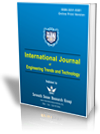Design and Implementation of Personal Finance Software for Controlling Financial Efficiency
Design and Implementation of Personal Finance Software for Controlling Financial Efficiency |
||
 |
 |
|
| © 2025 by IJETT Journal | ||
| Volume-73 Issue-2 |
||
| Year of Publication : 2025 | ||
| Author : Junior Grados-Espinoza, Linett Velasquez-Jimenez |
||
| DOI : 10.14445/22315381/IJETT-V73I2P109 | ||
How to Cite?
Junior Grados-Espinoza, Linett Velasquez-Jimenez, "Design and Implementation of Personal Finance Software for Controlling Financial Efficiency," International Journal of Engineering Trends and Technology, vol. 73, no. 2, pp. 107-118, 2025. Crossref, https://doi.org/10.14445/22315381/IJETT-V73I2P109
Abstract
This study presents the development and implementation of software designed to help individuals better manage their personal finances. Developed using agile methodologies such as Scrum and Extreme Programming (XP), the software integrates key features, including transaction tracking, personalized reports, and expense categorization, all within an intuitive and user-friendly platform. The results indicate that users highly valued the software’s ease of use and utility, highlighting its effectiveness in enabling more efficient and informed financial management. However, visual design was identified as an area for improvement, with some users noting that aspects such as aesthetics and organization could be optimized to enhance the overall user experience. Compared to existing tools, this software stands out for its user-centered approach and flexibility to adapt to different needs. Moreover, the methodologies applied enabled the development of a product that effectively addresses everyday financial challenges. This work not only meets its proposed objectives but also opens opportunities for future enhancements, such as integrating security features and personalization options and analyzing the long-term impact on users’ financial well-being. In summary, this software represents a significant step forward in creating practical and accessible tools for personal financial management. It empowers users to make more informed decisions and improve their relationship with their finances.
Keywords
Financial decisions, Personal finances, Software design, Software engineering, Web application.
References
[1] Eka Rosalina et al., “Household Financial Management with Personality Factors and Locus of Control through Mental Budgeting,” Economics, Business, Accounting & Society Review, vol. 1, no. 3, pp. 132-141, 2022.
[CrossRef] [Google Scholar] [Publisher Link]
[2] Paula Bitrian, Isabel Buil, and Sara Catalan, “Making Finance Fun: the Gamification of Personal Financial Management Apps,” International Journal of Bank Marketing, vol. 39, no. 7, pp. 1310-1332, 2021.
[CrossRef] [Google Scholar] [Publisher Link]
[3] Brilly Andro Makalew, “Android Based Personal Finance Management Application: Design and Development,” Engineering, Mathematics and Computer Science Journal, vol. 4, no. 1, pp. 5-9, 2022.
[CrossRef] [Google Scholar] [Publisher Link]
[4] Suharjanto Utomo, and Dede Badru Jaman, “Perancangan Perangkat Lunak Manajemen Keuangan Pribadi Berbasis Mobile Hybrid,” Journal of Information System Research, vol. 3, no. 4, pp. 712-717, 2022.
[CrossRef] [Google Scholar] [Publisher Link]
[5] Alhanoof Althnian, “Design of a Rule-Based Personal Finance Management System Based on Financial Well-being,” International Journal of Advanced Computer Science and Applications, vol. 12, no. 1, pp. 182-187, 2021.
[CrossRef] [Google Scholar] [Publisher Link]
[6] Alberic Aptatio Astri, and Lindrianasari, “Sampatti Personal Financial Management Application Development Integrated with Indonesian Stock Market Data,” International Conference on Information Management and Technology, Malang, Indonesia, pp. 475-480, 2023.
[CrossRef] [Google Scholar] [Publisher Link]
[7] Liana Dewi, “Comparison of Android-Based Personal Financial Management Applications with Variative Financial Conditions,” Journal of Islamic Accounting, vol. 7, no. 1, pp. 102-114, 2023.
[CrossRef] [Google Scholar] [Publisher Link]
[8] Manuel B. Garcia, and Julius P. Claour, “Mobile Bookkeeper: Personal Financial Management Application with Receipt Scanner Using Optical Character Recognition,” 1st Conference on Online Teaching for Mobile Education (OT4ME), Alcala de Henares, Spain, pp. 15-20, 2021.
[CrossRef] [Google Scholar] [Publisher Link]
[9] Mathursan Balathas et al., “Money Empire: Intelligent Assistant for Personal Finance Management,” International Journal for Research in Applied Science and Engineering Technology, vol. 10, no. 11, pp. 454-461, 2022.
[CrossRef] [Google Scholar] [Publisher Link]
[10] Kali Johari et al., “Navigating Financial Complexity: The Role of a Tailored Finance Tracker Application for Small Businesses,” First International Conference on Pioneering Developments in Computer Science & Digital Technologies (IC2SDT), Delhi, India, pp. 344-349, 2024.
[CrossRef] [Google Scholar] [Publisher Link]
[11] L.A. Rodina, and L.V. Zavyalova, “Personal Finance Management in Modern Conditions,” Bulletin of Omsk University: Series “Economics”, vol. 18, no. 4, pp. 36-47, 2020.
[CrossRef] [Google Scholar] [Publisher Link]
[12] Uyanahewa M.I.R. et al., “WONGA: The Future of Personal Finance Management - A Machine Learning-Driven Approach for Predictive Analysis and Efficient Expense Tracking,” 4th International Conference for Emerging Technology (INCET), Belgaum, India, pp. 1-6, 2023.
[CrossRef] [Google Scholar] [Publisher Link]
[13] Vaishali Rajput et al., “Moneymate: A Finance Application,” International Journal For Research in Applied Science and Engineering Technology, vol. 12, no. 4, pp. 5248-5253, 2024.
[CrossRef] [Publisher Link]
[14] Anna I. Pavlova, and Nikita S. Kuskov, “Developing the Structure of a Web Application for Personal Finance Accounting,” Science of Krasnoyarsk: Economic Journal, vol. 11, no. 3, pp. 96-106, 2022.
[CrossRef] [Google Scholar] [Publisher Link]
[15] Neha Rajas et al., “Money Management App for Expense Planning Based on Flutter,” International Journal for Research in Applied Science & Engineering Technology, vol. 11, no. 11, pp. 2068-2072, 2023.
[CrossRef] [Publisher Link]
[16] Tihomir Stefanov et al., “Personal Finance Management Application,” TEM Journal, vol. 13, no. 3, pp. 2066-2075, 2024.
[CrossRef] [Google Scholar] [Publisher Link]
[17] Lucas Schneider Muller et al., “ADAM: An Intelligent Virtual Assistant for Personal Financial Management,” SBSI '22: Proceedings of the XVIII Brazilian Symposium on Information Systems, Curitiba, Brazil, pp. 1-8, 2022.
[CrossRef] [Google Scholar] [Publisher Link]

